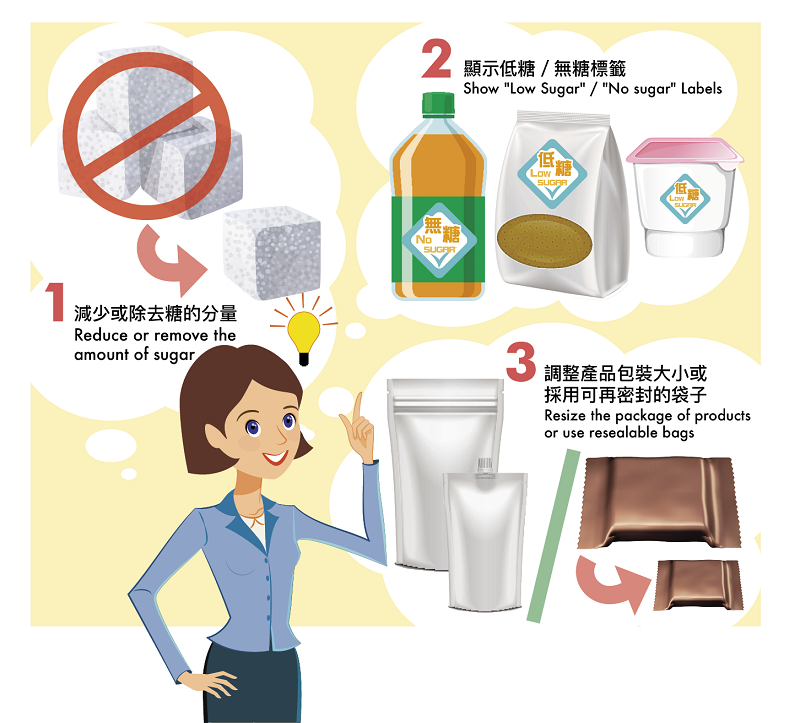
Food Safety Focus (139th Issue, February 2018) – Food Safety Platform
Reduction of Sugars in Prepackaged Foods and Beverages
Reported by Dr. Anna S.P. TANG, Scientific Officer
Risk Communication Section,
Centre for Food Safety
Following the previous article on sodium intake in this series, dietary sugar intake is another factor closely related to health. Besides the increased risk of dental caries from consuming free sugars (monosaccharides and disaccharides) in the diet, excess calories from foods and beverages high in free sugars can contribute to unhealthy weight gain, in turn leading to obesity, diabetes and other non-communicable diseases (NCDs). In 2015, the World Health Organization (WHO) set out new guidelines calling for a reduced intake of free sugars throughout the life course, to less than 10% of total energy intake for both adults and children, in order to avoid negative health impacts. The WHO also makes a conditional recommendation and suggests a further reduction of the intake of free sugars to below 5% of total energy intake if possible.
Reducing Levels of Free Sugars in Prepackaged Foods and Beverages
Food products containing free sugars are widely available in the market as prepackaged foods and beverages. In order to reduce the population intake of free sugars for the prevention of NCDs, some countries have established sugar reduction targets, while others have introduced taxation in sugary products, with an aim to result in changes such as reformulation and resizing of the products by the trade, as well as reduced purchasing and consumption by the public. For example, the government of the United Kingdom (UK) has set a target to reduce overall sugar content across a range of products that contribute most to children’s sugar intakes by at least 20% by 2020 as compared with the 2015 base-line levels. For some countries (e.g. France, Mexico), taxation is already in place for the sugary drinks/soft-drinks industry, while others (e.g. UK) have plans to introduce the sugar levy.
Initiatives and ways to reduce sugar contents in prepackaged foods/beverages.
Product Reformulation
Free sugars, besides being naturally present in honey, syrups, fruit juices and fruit juice concentrates, are often added to prepackaged food and beverage products on the market. Non-alcoholic beverages (NABs) including prepackaged tea, carbonated drink, fruit and vegetable juice/juice drink are significant total sugar intake contributors in Hong Kong. Carbonated drinks and juice drinks are targets for product reformulation in many places. In some countries (e.g. UK), a maximum level of sugar in prepackaged beverage products is set as the recommended target level for reformulation.
Reduction of sugars in prepackaged foods and beverages may be achieved by sourcing ingredients with lower sugar contents, adding less free sugars in the products or by using sugar substitutes. Some examples of product reformulation include reducing the amount of added sugars in yoghurts by replacing with fruits, providing no added sugar products for breakfast cereals, and replacing sugars in biscuits with fibre. The trade is encouraged to make reference to current technological resources available to achieve reformulation for sugar reduction.
“Salt/Sugar” Label Scheme for Prepackaged Food Products
In Hong Kong, the Committee on Reduction of Salt and Sugar in Food and the Government jointly introduced a voluntary “Salt/Sugar” Label Scheme for Prepackaged Food Products in October 2017 to assist consumers to easily identify low-sugar products. Trade members can display the labels on their prepackaged foods and beverages which meet the claim conditions of “low sugar” and “no sugar” under the Food and Drugs (Composition and Labelling) Regulations (Cap.132W). The scheme would help consumers select reduced sugar options.
Trade Participation
Reformulation to lower the levels of free sugars present in the products, reducing portion size, and using package labelling to shift consumer habits to purchase lower/ no added sugar products are useful ways to achieve better public health through reduced sugar intake. Sugar reduction can be successfully achieved by joint efforts of the government, trade and consumers. Trade members should be aware of the sugar contents of their products, actively participate in reducing sugar contents to reformulate recipes, and make greater efforts to provide less/no added sugars alternatives, with reference to the Trade Guidelines for Reducing Sugars and Fats in Foods developed by the CFS. Consumers can then make informed choices based on nutrition labels and the “Salt/Sugar” Labels to choose prepackaged foods and beverages with lower sugar contents for better health.



